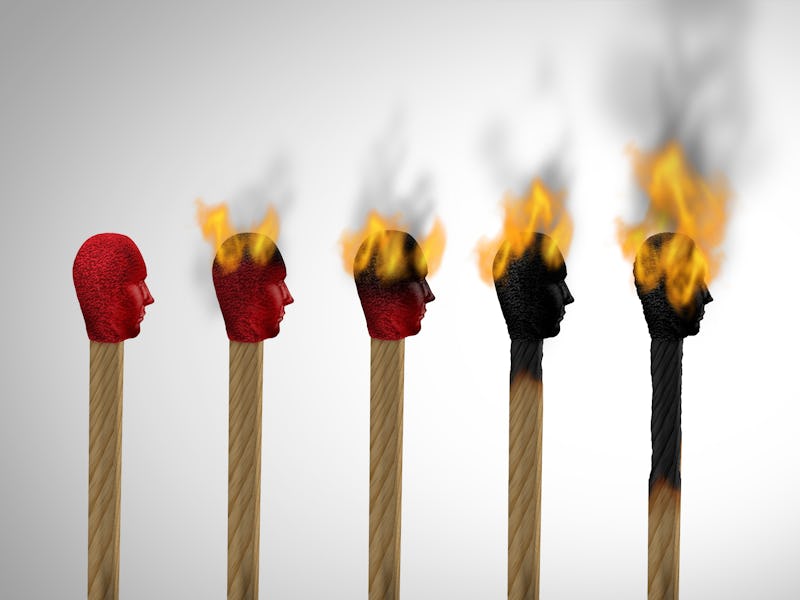How stress changes the brain may explain one of depression's most troubling traits
A new study in rats hints at a potential treatment for depression.

Not all stress is bad, but sometimes, stress can spiral out of control. Chronic, intense stress can pave the way to depression — a connection that’s both logical, yet biologically perplexing. It makes sense that out-of-control stress may lead to feeling depressed — but that doesn’t answer how the two tie together. And why do some people seem to just shrug stress off, while others end up with lasting mental health struggles?
The key factor may be serotonin — a neurotransmitter that’s usually less abundant in people who have depression.
That’s the upshot of a new study published this week in The Journal of Neuroscience.
Rats that developed a core feature of depression — the inability to feel pleasure — had more serotonin-producing neurons in their brains than those who didn’t, according to the study.
The finding is counterintuitive: After all, people with depression often have a deficit of serotonin. But it may illuminate a biological pathway in which stress transforms the way the brain usually produces serotonin, the study suggests. And if they hold up in people, the results also point towards a way to “elicit resilience” to depression, the researchers say.
For some people, stress can contribute to depressive symptoms. That connection may be linked to serotonin-producing neurons in the brain.
How stress changes the brain
The study, which was overseen by senior authors Davide Dulcis and Andre Der-Avakian at the University of California San Diego, investigated how stress is related to anhedonia — the inability to feel pleasure. It’s that feeling that nothing — even things you used to find enjoyable — is fun anymore.
In the study, rats were trained to spin a wheel that activated an electrode implanted in the reward circuits of their brains. When they spun the wheel, the circuits were activated, ostensibly causing the rats to feel good.
But after weeks of “chronic social defeat,” some rats’ reward circuits were less active than others — suggesting they are “susceptible” to adhedonia, the researchers propose. They also tended to have more serotingergic neurons in the dorsal raphe nucleus, an area of the brain that acts as a major source of serotonin.
Where did these new serotonin-manufacturing neurons come from? The adult brain doesn’t make new neurons on command. But in this case, other neurons in the brain may be “recruited” to manufacture serotonin, the study suggests. Stress sets the recruitment process in motion.
Nandkishore Prakash, a Ph.D. student in Dulcis’ lab and the study’s first author tells Inverse that recruitment process represents a “new form of plasticity” that can explain how serotonin and stress plays a role in the development of depression.
“Why does stress not lead to symptoms of depression in every stressed individual? We now know that the serotonergic system demonstrates a form of plasticity, hitherto unknown, that is strongly correlated to the behavioral susceptibility of a rodent to stress-induced depression (anhedonia),” Nandkishore says.
This jibes with the idea that the brain behaves unusually as a result of stress. In other words, stress itself can cause certain neurons to produce neurotransmitters they may not have under other conditions.
“Promoting resilience”
The findings point to a molecular marker that could explain why some people with chronic stress spiral into anhedonia. To turn this theory into a treatment strategy, the study puts forward an approach that reverse-engineers the process — and it starts with yet another population of neurons in the brain.
Activating a different group of neurons that form a major input to the dorsal raphe nucleus reduced the amount of serotonin signaling in the area, the researchers find. That lessened the rats’ anhedonia, suggesting they became more resilient to the affects of stress.
The next step, the researchers say, is to find less invasive ways to promote resilience to depression’s core traits. But the study hints at the idea that it is possible — if only in rats, for now.
“It is an early step on the road towards translational benefits for society,” says Prakash.
Abstract:
Chronic stress induces anhedonia in susceptible but not resilient individuals, a phenomenon observed in humans as well as animal models, but the molecular mechanisms underlying susceptibility and resilience are not well understood. We hypothesized that the serotonergic system, which is implicated in stress, reward and antidepressant therapy, may play a role. We found that plasticity of the serotonergic system contributes to the differential vulnerability to stress displayed by susceptible and resilient animals. Stress-induced anhedonia was assessed in adult male rats using social defeat and intracranial self-stimulation (ICSS), while changes in serotonergic phenotype were investigated using immunohistochemistry and in situ hybridization. Susceptible, but not resilient, rats displayed an increased number of neurons expressing the biosynthetic enzyme for serotonin, tryptophan-hydroxylase-2 (TPH2), in the ventral subnucleus of the dorsal raphe nucleus (DRv). Further, a decrease in the number of DRv glutamatergic (VGLUT3+) neurons was observed in all stressed rats. This neurotransmitter plasticity is activity-dependent, as was revealed by chemogenetic manipulation of the central amygdala, a stress-sensitive nucleus that forms a major input to the DR. Activation of amygdalar corticotropin releasing hormone (CRH)+ neurons abolished the increase in DRv TPH2+ neurons and ameliorated stress-induced anhedonia in susceptible rats. These findings show that activation of amygdalar CRH+ neurons induces resilience, and suppresses the gain of serotonergic phenotype in the DR that is characteristic of susceptible rats. This molecular signature of vulnerability to stress-induced anhedonia and the active nature of resilience could be targeted to develop new treatments for stress-related disorders like depression.
Editor’s Note 12/2/19: This story has been updated to include comment from the study’s first author, Nandkishore Prakash.